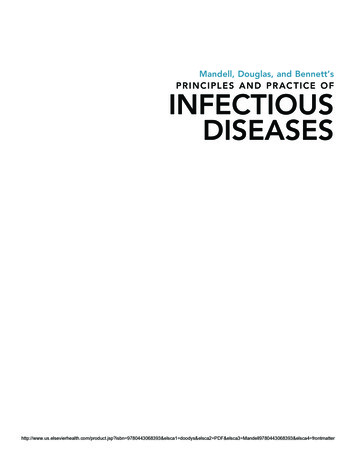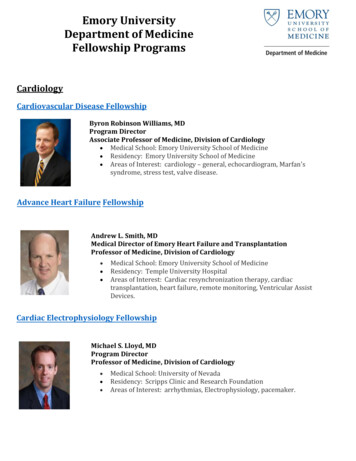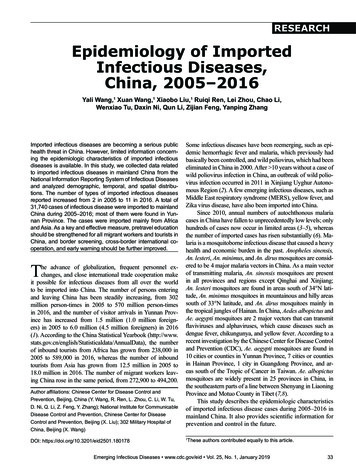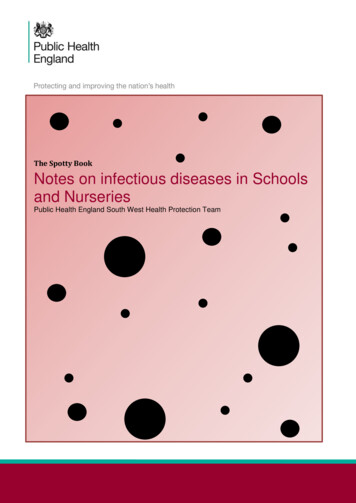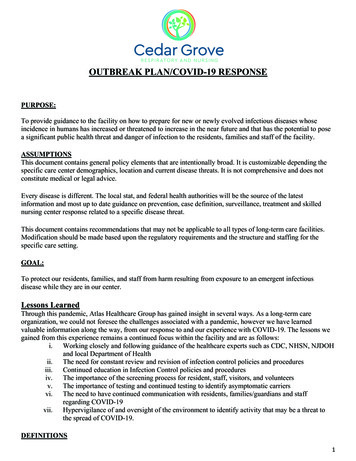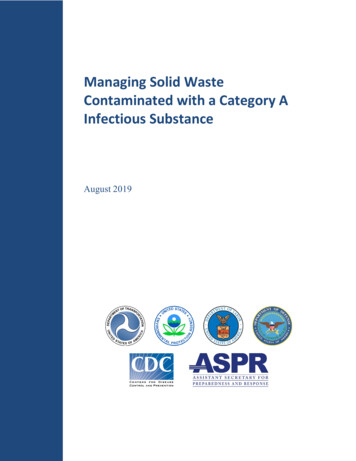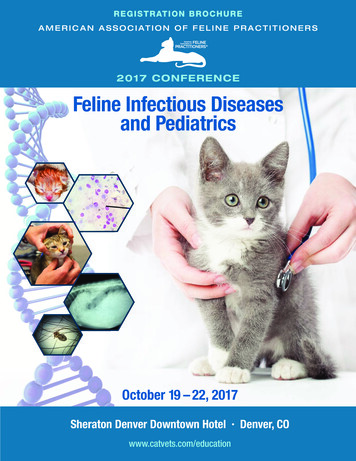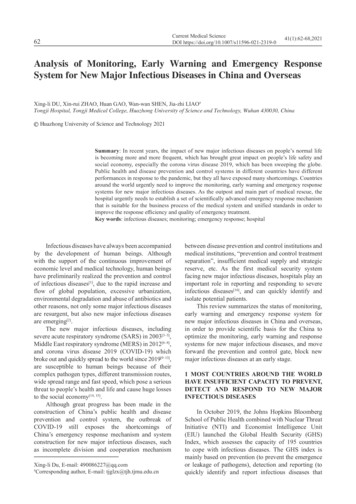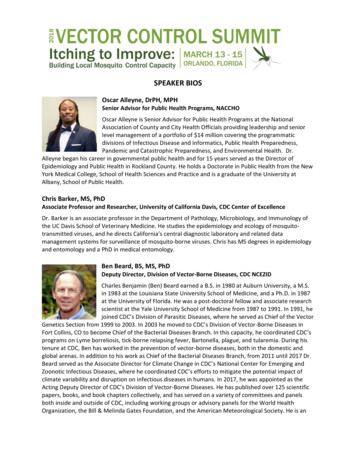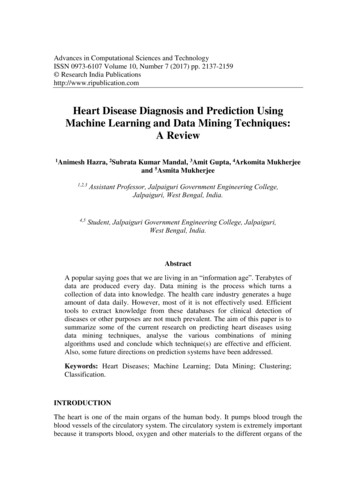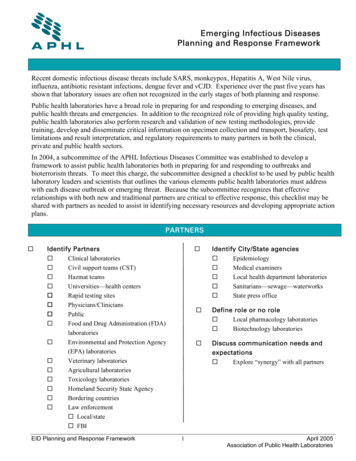
Transcription
Emerging Infectious DiseasesPlanning and Response FrameworkRecent domestic infectious disease threats include SARS, monkeypox, Hepatitis A, West Nile virus,influenza, antibiotic resistant infections, dengue fever and vCJD. Experience over the past five years hasshown that laboratory issues are often not recognized in the early stages of both planning and response.Public health laboratories have a broad role in preparing for and responding to emerging diseases, andpublic health threats and emergencies. In addition to the recognized role of providing high quality testing,public health laboratories also perform research and validation of new testing methodologies, providetraining, develop and disseminate critical information on specimen collection and transport, biosafety, testlimitations and result interpretation, and regulatory requirements to many partners in both the clinical,private and public health sectors.In 2004, a subcommittee of the APHL Infectious Diseases Committee was established to develop aframework to assist public health laboratories both in preparing for and responding to outbreaks andbioterrorism threats. To meet this charge, the subcommittee designed a checklist to be used by public healthlaboratory leaders and scientists that outlines the various elements public health laboratories must addresswith each disease outbreak or emerging threat. Because the subcommittee recognizes that effectiverelationships with both new and traditional partners are critical to effective response, this checklist may beshared with partners as needed to assist in identifying necessary resources and developing appropriate actionplans.PARTNERSIdentify City/State agenciesEpidemiologyMedical examinersLocal health department laboratoriesSanitarians—sewage—waterworksState press officeIdentify PartnersClinical laboratoriesCivil support teams (CST)Hazmat teamsUniversities—health centers Rapid testing sites Physicians/Clinicians PublicFood and Drug Administration (FDA)laboratoriesEnvironmental and Protection Agency(EPA) laboratoriesVeterinary laboratoriesAgricultural laboratoriesToxicology laboratoriesHomeland Security State AgencyBordering countriesLaw enforcementLocal/stateFBIEID Planning and Response FrameworkDefine role or no roleLocal pharmacology laboratoriesBiotechnology laboratoriesDiscuss communication needs andexpectationsExplore “synergy” with all partners1April 2005Association of Public Health Laboratories
COMMUNICATIONSDefine/Implement pubic healthlaboratory (PHL) emergencyresponse system (outbreak planbeyond bioterrorism)Establish incident command systemEstablish who’s in chargeKeep system updatedDefine record keeper for eventDefine call back system for technicalstaff (beyond bioterrorism) andpackaging staffExercise the system and test the callback systemDisseminate state health alertnetwork (HAN) information tosentinel laboratoriesWhat is happeningWhat they need to know (includingsafety)What public health laboratories needsto knowWho they need to contactWhat they need to doLaboratory communityEstablish relationshipsEstablish one stop shop numbers and24/7 numbersPre-establish state testing and datasharing capabilitiesArrange face to face interactionsEstablish contact with state healthofficer (SHO)Establish/Utilize system tocommunicateFax or emailTeleconferences with public healthpartnersTeleconferences with sentinellaboratories Conference calls (identify who toinclude) Just in time decisions—who needs tobe includedCommunication with epidemiologyand clinical consultantEstablish routine communication withepidemiology in advancePlan for emergency communicationsConnect with epidemiology for CDCfifty-state callsPrivate sectorCommunicate public health laboratory24/7 response roleDifferentiate from “routine” testingAssure PHL is reachable 24/7Define what is an emergency (beyondbioterrorism), if possible; e.g.:botulism, meningitis, foodborneoutbreakEstablish laboratory partner lists withcontact informationSentinel laboratoriesVeterinary laboratoriesAgricultural laboratoriesAcademia/Research laboratoriesEnvironmental laboratoriesSurrounding state public healthlaboratories (SPHL)EID Planning and Response FrameworkEvery PHL should participate in Epi-XUse Epi-X info to send out state HANmessages2April 2005Association of Public Health Laboratories
COMMUNICATIONSPublic health laboratory (PHL) to CDCEstablish how to connect withlaboratoriesEstablish role of emergencyoperations center (EOC)Establish role of APHL to help youconnect with CDCEstablish and clarify role of chiefcommunications officerObtain information and resourcesfrom APHLParticipate in 50 state calls formember laboratoriesUse APHL to represent PHLs “voice”Review and share information withstaff in SPHL, branch, city and countylaboratoriesOthers within SPHLCities/CountiesProvide names of technicalcontacts to APHLPublic Relations—“Role ofLaboratories”APHL may develop samplepress releases for states to useIssue state press releaseClarify expectations from CDC (withAPHL) to obtain information andresources neededDisease, technical informationWho to contactConference calls as much as neededwith effected areasLarger communication to all statesLaboratory specific communicationsOptimize use of available electroniclaboratory capabilitiesUtilize public information officer(PIO) where available to developadvance messages and communicatemessages or data/informationchanges during the eventPHL websiteSet up educational pages in advanceKeep contact information updatedSAFETYMake sure appropriate biosafetyequipment is available and usedProvide training and send updated oremergency informationSentinel laboratoriesPHL staffTransportation requirementsMust have standard BSL practiceswell established and monitorpractices in the laboratory (e.g.standard precautions for respiratorysamples)Develop a contingency plan forbreach of biosafety level (BSL) (e.g.unknown that was processed withoutproper containment)Establish, update and implementcriteria for use of personal protectiveequipment (PPE) and powered airpurifying respirators (PAPRs)including certificationCommunication with epidemiologyEpidemiology-clinical indicators ofincreased BSL risk organismEID Planning and Response Framework3April 2005Association of Public Health Laboratories
SAFETYDevelop and implement acontingency plan and riskassessment for:BSL3 enhancedBSL3 with agriculture enhancements(USDA requirements)Unknown virus/unknown organismDefine algorithm for high risk samplesand suspicious culture resultsDefine BSL stop points for unusual orsuspicious growth in cultureUpdate and maintain safetydocumentsIdentify safety officerParticipate in BSL-3 training (e.g.Eagleson Institute)Develop vaccinationrequirements/plans andmonitor/implement any new CDCguidanceEstablish plan for medicalsurveillance of laboratory staffIdentify an infectious disease expertconsultant (work through medicaldirector)Bank sera—define storagerequirements (if off-site)Define and review criteria for role ofenvironmental monitoring(implement, if needed)REGULATORYMaintain knowledge of CLIArequirements for new testimplementation & reporting non-FDAapproved test results and evaluateimpact to laboratoryMaintain knowledge of federalpartner requirements/role (e.g. FDA,USDA/APHIS)Maintain updated knowledge ofpackaging and shipping regulationsand assure complianceCoordinate with epidemiology toimplement institutional review board(IRB)/informed consent requirements,e.g. Investigational New Drug (IND),Investigational Device Exemption(IDE)Assure select agent registration isupdated and review select tablish a directory of servicesRefer to examples available frompublic health laboratories and clinicallaboratoriesKeep specimen collection informationguide for “routine” types of specimensup to dateEID Planning and Response FrameworkIdentify specimen types (coordinatewith epidemiology department whereappropriate)From CDC case definitionFrom best available science (pre-planmessages)4April 2005Association of Public Health Laboratories
SAMPLES—SPECIMENS—TRANSPORTCollection devices/kitsDefine what is neededDefine what is/will be available frompublic health laboratoryIdentify courier options already inuse by sentinel laboratories (tap inwhere possible)Plan for various alternatives andpackaging requirementsLocal transportCourierOvernightReview test order form and distributeif unique to eventUpdate if neededAsk only for essential information(partner with physicians) e.g. travelhistory, animal exposure only ifappropriate to outbreakDevelop and implement a plan forsample triage and prioritization (linkwith epidemiology and lawenforcement)Establish repositories of kits in localregional jurisdictions (e.g. localhealth departments)Develop a plan and communicaterequirements for direct shipping ofsamples from local to CDC whenurgentPlan for informed consent (link withepidemiology)Do you need local IRB and CDCapproval?What to do if informed consent is notreceivedUpdate and distribute forms; provideon websiteCommunicate informed consentrequirements to laboratory and clinicalpartnersPlan for things to change (e.g.sampling and testing guidance)Be prepared to communicate changesto partners quicklyCommunicate role of environmentaltesting and sample requirements forthe eventEstablish advance plan if possibleClarify responsibilities for testing (e.g.BT vs. infection control—hospitaloutbreak)Packaging and ShippingProvide advanced training orresources for training to sentinellaboratories (if available) and lawenforcementDefine and distribute PHLexpectations for this event toproviders, laboratory community, andlaw enforcementAssure compliance with 24/7 contactnumber requirement on shippingdocumentsAssure chain of custodyEID Planning and Response Framework5April 2005Association of Public Health Laboratories
TESTINGDetermine minimal verification—validation plan for tests developedand released in an emergencyDetermine and communicateconfirmatory testing requirementsWhere, what?Quality Control—determine what isavailable and how to accessProficiency testing—determine whatis available and how to accessDiscrepant result analysisIdentify available reagent sourcesand stock reagents where possibleObtain emergency reagents if neededIdentify testing/resources inacademiaDefine and communicate role of/needfor molecular subtypingTechnologyEstablish testing on multiple platforms(if possible)Participate in vendor user groupsDefine and communicate role ofsequencingFor identification of unknownsSafety issuesIdentify and define role of availabletestsValidate methods where possibleAssist CDC/partners in validationwhen neededParticipate in proficiency testing (PT)when availableDetermine appropriate use of in-housedeveloped testsCarefully justify legal implications ofany in-house modification of CDCproceduresEstablish criteria for role ofsurveillance or environmental testingand communicate planImplement and communicateappropriate testing algorithms (CDCguidance) to essential partnersDevelop and implement contingencyplan if you don’t have neededtechnology (memorandum ofunderstanding, MOU)Plan communication to “qualify” testresults of new tests/technologiesAdd qualifiers to reporting formsAddress state regulations that mayimpede additional testing—“publichealth surveillance testing”Need to find out who/what is availableWhere is expertiseDetermine and communicate role oftesting for other agentsRule out/rule inHow far to go with unknownsEID Planning and Response Framework6April 2005Association of Public Health Laboratories
TESTING IN THE PRIVATE SECTORAssess private sectorcapabilities/capacityIdentify who and what can be tested inadvanceDetermine capabilities beyondbioterrorism (e.g. rapid flu)Determine biosafety capabilitiesCommunicate with private sectorexpectations for testingCommunicate expectations forsending samples to PHLShare protocols with private sectorCommunicate public health need forprivate sector test results (e.g. foodborne outbreaks, surveillance)Need to involve state public healthagency pre-testing (e.g. SARS)-casedefinition fitCommunicate messages on quality ofprivate homebrew testingCommunicate need to obtainspecimens for confirmatory testingand sub-typingCommunicate messages on role ofpublic health/private testingCommunicate need/impact on publichealth responsePublic health impact of positive, falsepositive, false negative resultsREPORTING/DATA MANAGEMENTDevelop standardized reportingalgorithmsContinue to assess and implementreporting algorithmsAssess Data managementrequirementsIdentify lead staff and surge staff forreporting and provide trainingCommunicate reporting plan inadvance to essential partnersKnow reporting requirements(expectations) ofLocal health departmentsState epidemiologistsCDCDevelop plan for dealing withpressure to release resultsEpidemiology and laboratory staffsneed to be on same pageCDC guidance on test performanceDeal with delays in CDC testingCoordinate with state press officeProvide media training forLaboratory Director, Deputy Director,and Communications OfficerUtilize public information officer(PIO) where available to developadvance messages and communicatemessages or data/informationchanges during the eventEstablish and clarify role of chiefcommunications officer in releasingresultsEID Planning and Response Framework7April 2005Association of Public Health Laboratories
STAFFINGParticipate in CDC training, assesscompetencyDevelop a plan for shift coverageMaintain select agent registration ofnew staffAssess select agent registration impacton staff responsibilitiesIdentify expertise/special skillsImplement cross-training, assesscompetencySURGEProvide cross-training, assesscompetencyBy methods groupsAcross bacteriology—virologyEstablish emergency response plansDefine potential needsDevelop a plan for shift coverageDefine roles of all staff in the eventImplement emergency staffing plans ifneededDevelop contingency plan to prioritizetesting (routine clinical vs. response),outsource or reduce routine testingEstablish and implement MOUswhere neededLink to state continuity of operations(CoOp) planIdentify available reagent sourcesCDCCommercial: talk to vendors aboutemergency supplies (e.g. extraction)Stockpile appropriate reagentsInventory and stockpile PPE suppliesAssess clinical laboratory capacityDefine clinical laboratory role in theevent and communicate quickly withlaboratoriesAssess PHL capacityTestingStaff and supervisory staffSecuritySpaceInformation technology (IT)Define role of CDC for back-up,surge, confirmatory testingMISCELLANEOUSIdentify funding opportunitiesIdentify common elements toexisting plansEmergency responseInfluenzaSARSEstablish and maintain a securityplanThis Emerging Infectious Diseases Planning and Response Framework was supported under CooperativeAgreement #U60/CCU303019 between the Centers for Disease Control and Prevention, BioterrorismPreparedness and Response Program and the Association of Public Health Laboratories.8
private and public health sectors. In 2004, a subcommittee of the APHL Infectious Diseases Committee was established to develop a framework to assist public health laboratories both in preparing for and responding to outbreaks and bioterrorism threats. To meet this charge, the subcommittee designed a checklist to be used by public health
